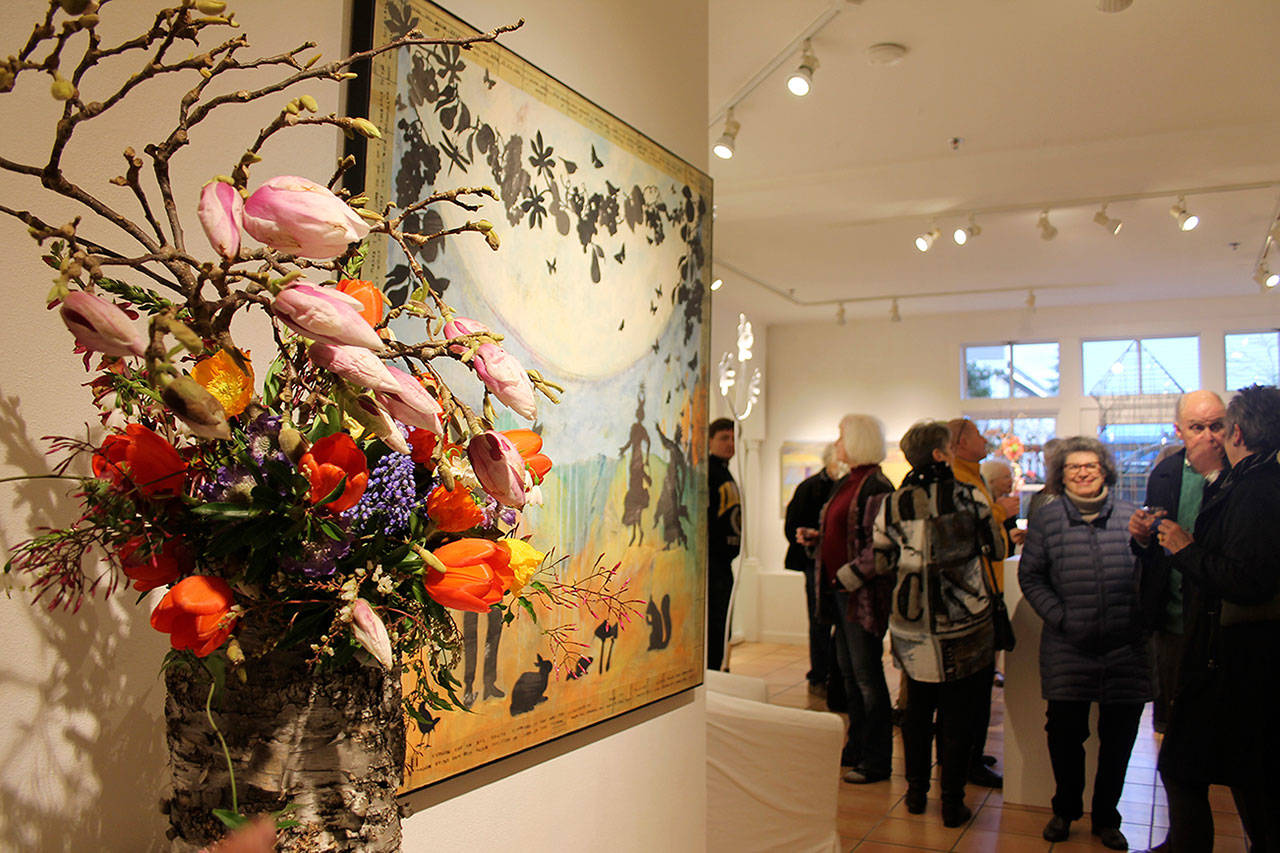For flower farmers and florists like Tobey Nelson and Melissa Brown, designing arrangements is an art form in its own right.
Yet, opportunities to showcase their work in a contemporary fine art exhibit don’t come around often. Museo in Langley got that chance this past weekend with an exhibit that pairs flower arrangements with art.
“The point is to help people understand that working with flowers is an art,” Langley resident and former Seattle Times garden columnist Valerie Easton said. “Also, the nature of flowers is so ephemeral in nature, unlike art, which is permanent. That juxtaposition is very interesting.”
The exhibit is Museo’s 2017 rendition of its annual garden show. The art gallery typically showcases the event to usher in the spring bloom, displaying multi-media pieces from local artists inspired by the season. Paintings of blooming flora, sculptures that naturally blend in with gardens and functional art are typically found in the annual showcase, but gallery owner Sandra Jarvis was inspired by Easton’s suggestion to incorporate South Whidbey-based flower farmers into this year’s exhibit.
The idea was spawned from a similar event held at the DeYoung Museum in San Francisco. Museo artists were tasked with creating a piece with a spring theme. Five flower farmers were then challenged to design an arrangement based off one of the artworks, which would later be displayed beside the inspiring piece.
The five featured flower farmers are Melissa Brown, Pam and Kelly Uhlig, Tobey Nelson, Jodi Starcevich and Britt Conn. Due to the short-lived nature of flowers, the arrangements were on display during the show’s opening weekend before being auctioned off to benefit Good Cheer. The gallery raised $825 from the auction. The garden show will continue throughout April, and photos of the arrangements are shown next to the art pieces.
“I think this is a fantastic opportunity to connect art and nature,” Brown, co-owner of Flying Bear Farm, said. “I actually tend to see what I do as art.”
Flower farmers such as Brown and Nelson saw the exhibit as a way to flex their creative muscle. Brown said it afforded much more creative room than what weddings and events allow for. Yet both say they typically see their work as a sculpture, and look for many of the same things they would imagine an artist looks for.
“When I make a centerpiece, I consider a lot of the same design principles that I’m sure an artist does, like line, color, space, mass,” Nelson, who owns her own events and design company, said. “Those design principles are crucial to any art.”
For Brown, who was tasked to create something from a Kris Ekstrand Molesworth mixed media piece of a nest made from sharp lines of charcoal, she was inspired by the movement of the lines and color of the charcoal over a white backdrop. With the black and white color scheme in mind, she designed a nest-like arrangement with subtle colors and flowering branches to imitate the materials needed to make a nest.
Easton says the art show is a great way to promote flower farmers on Whidbey. Having written about gardens for such a long time as a columnist, she’s grown increasingly impressed with the quality of young flower farmers, particularly on South Whidbey. Easton says her former editor would regularly tell her to write about a garden not on the island, since the many lush gardens across Whidbey regularly grabbed her attention.
Flower farming has grown to be a viable career on Whidbey, Easton says. In the past few years, farms run typically by younger individuals have popped up across the island. That’s a result of the increased demand for locally-grown, seasonal flowers as consumers become more conscious of how their flowers are sourced. Easton and the farmers say most are “chemically-doused” flowers grown by underpaid workers in South American countries such as Ecuador and Brazil.
“People want seasonality these days,” Brown said. “Even the aesthetic trend is moving toward flowers that are more fragile and ephemeral that don’t ship well, so you have to have a local flower farmer.”
Whidbey Island and Skagit Valley are at the forefront of “an exciting new national movement toward locally-grown, organic, in-season flowers,” according to Easton. Nelson agrees with that assessment, and said Whidbey farmers contribute to Puget Sound’s burgeoning locally-grown scene.
It makes for good eye candy throughout the island, and seems to be elevating the art of the flower.
“I think the exhibit encouraged people to think about the flower farmers in a different way,” Easton said. “I think it helps people realize how beautiful they are.”


